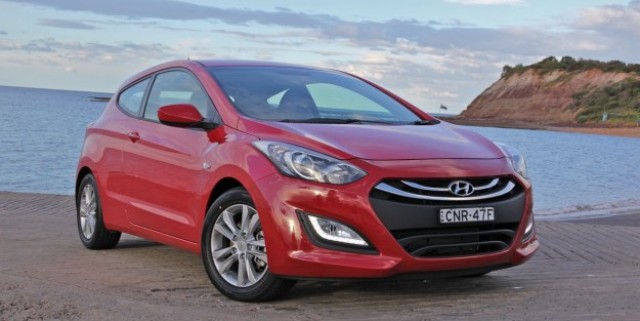
Less than a year since the concept debuted at the 2012 Paris Motor Show, the Hyundai i30 three-door Special Edition takes over as the Korean manufacturer’s latest entry model in its small car line-up.
Priced from $19,990 driveaway, it is also the third and last body style we’re likely to see in Hyundai’s second-generation i30 range.
It follows the popular five-door hatch and more recently launched i30 Tourer (wagon) models.
It also distinguishes Hyundai as the only small car manufacturer to offer a three-door variant in Australia’s small car segment, with rival models such as the Toyota Corolla and Mazda 3 currently available only in five-door and sedan versions.
Oddly enough, Hyundai doesn’t produce an i30-badged sedan, choosing instead to call their small-car contender the Elantra in line with the car maker’s global naming policy.
As a general guide, three-door hatchbacks tend to look sportier than their five-door counterparts and the Hyundai i30 Special Edition is no exception to the rule.
By losing the rear doors, designers can take advantage of a cleaner canvas, allowing three-door hatches like the new Special Edition to boast a decent amount of designer flair.
Cosmetic tweaks include revised bumpers, new foglamps and a sportier grille, but the three-door i30 also gets a more rakish profile than the five-door thanks to its upswept beltline and smaller rear windows.
And despite its competitive price tag, the i30 three-door is anything but the usual poverty-pack normally associated with entry-level offerings in this segment.
For starters, there are LED daytime running lights with integrated front fog-lamps and 16-inch alloy wheels, with a full-size spare included. The remodeled lower bumper also houses rear parking sensors and new horizontal fog-lamps in the lower air dam.
Inside, the Special Edition boasts a host of standard equipment including a five-inch touchscreen, six-speaker audio unit, Bluetooth phone and music streaming, and multifunctional steering wheel adjustable for both reach and rake.
Power windows, remote keyless entry, glovebox cooling and cruise control are also standard.
While the three-door layout is understandably less convenient than its five-door sibling when it comes to rear-seat access, it’s made less awkward by the easy ‘911-style’ front seat folding levers.
Rear leg and head space isn’t overtly compromised, either – in fact, it’s generous back there.
There are no rear air vents, though, and given the smaller rear windows don’t open, long stints in the rear seats may not be such a great idea, especially in summer.
There is plenty of luggage space, with up to 378 litres available with the rear seats in place – expanding to 1316 litres when folded (not flat).
An underfloor compartment that can take laptops supplements that space. There’s also a raft of additional storage spaces throughout the cabin for wallets, phones and drink bottles.
Styling is about the limit of this i30’s sporty pretensions. Power for the Czech-built hatch comes from Hyundai’s 1.6-litre direct-injection petrol engine, producing 98kW and 163Nm of torque – slightly less than the 110kW/178Nm output from the standard 1.8-litre unit in the five-door petrol version.
It’s certainly no firecracker, with peak torque not arriving until 4850rpm, but it is a smooth-revving engine and the six-speed manual gearbox is slick and precise, adding a modicum of pleasure to the on-board driving experience.
There’s also a six-speed automatic transmission available for an additional $2200, taking the driveaway price for the i30 three-door up to $22,190.
Hyundai claims 6.3L/100km combined fuel consumption for the manual (tested), but we could only manage an average of 8.2L/100km given there’s a tendency to want to rev this engine out more often than not, due to its lower torque output.
The ride, though, is excellent.
The Hyundai i30 three-door, like it’s Czech-sourced Tourer sibling, benefits from an independent rear suspension (the Korean-built five-door uses a simpler torsion beam setup) and European tune that effectively absorbs the bumps for excellent comfort.
The cloth seats help, too, providing plenty of backside- cushioning and better than adequate bolstering.
Hyundai’s ‘Flex-steer’ tri-mode electric steering is inherited from the five-door and, regardless of mode chosen, remains an area for improvement in terms of precision and weighting consistency.
However, there’s decent front-end grip from the 205/55 Hankook tyres and plenty of poise in corners.
Like its five-door counterparts, the i30 Special Edition comes with a comprehensive suite of active and passive safety gear including electronic stability control with traction control, anti-locking brakes with electronic brakeforce distribution and brake assist and seven airbags.
The Hyundai i30 three-door also comes under the company’s iCare umbrella, which offers a five-year unlimited kilometre warranty, capped-price servicing over three years ($219 for 15,000km, 30,000km and 45,000km services) and free roadside assistance for 12 months.
Overall, the Hyundai i30 three-door is a stylish and savvy choice for first-time buyers.
It’s not often that an entry-level price tag can offer such a comprehensive and generous range of standard features, teamed with such impressive all-round package. Throw in its stripped-back styling and the i30 three-door could well be a niche-defining hit for Hyundai.





